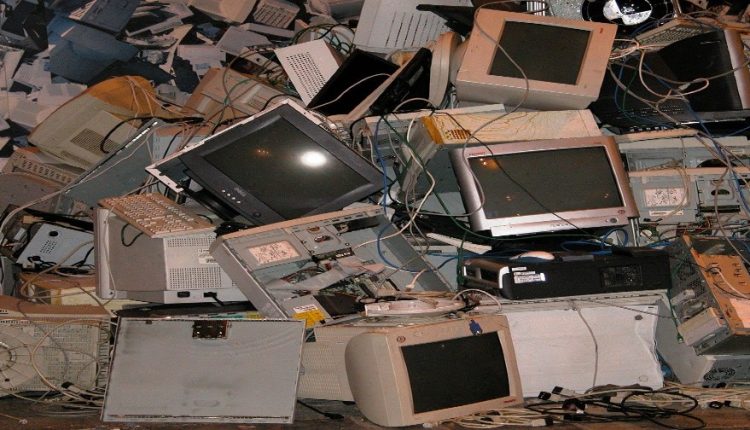Global E-waste Equaled 350 Queen Marys in 2019
Electronic consumption drives much of our global economy but takes a toll at both ends: significant increases in precious metals mining in production and large quantities of electronic waste that are not being recycled or safely disposed of.
A record 53.6 million metric tonnes (Mt) of electronic waste was generated worldwide in 2019, up 21% in just five years, according to the UN’s Global E-waste Monitor 2020.
The new report also predicts global e-waste — discarded products with a battery or plug — will reach 74 Mt by 2030, almost a doubling of e-waste in just 16 years. This makes e-waste the world’s fastest-growing domestic waste stream, fueled mainly by higher consumption rates of electric and electronic equipment, short life cycles, and few options for repair.
Only 17.4% of 2019’s e-waste was collected and recycled. This means that gold, silver, copper, platinum and other high-value, recoverable materials conservatively valued at US $57 billion — a sum greater than the Gross Domestic Product of most countries — were mostly dumped or burned rather than being collected for treatment and reuse.
According to the report, Asia generated the greatest volume of e-waste in 2019, some 24.9 Mt, followed by the Americas (13.1 Mt) and Europe (12 Mt), while Africa and Oceania generated 2.9 Mt and 0.7 Mt respectively.
For perspective, last year’s e-waste weighed substantially more than all the adults in Europe, or as much as 350 cruise ships the size of the Queen Mary 2, enough to form a line 125 km long.
E-waste is a health and environmental hazard, containing toxic additives or hazardous substances such as mercury, which damages the human brain and / or coordination system.
Other key findings from the Global E-waste Monitor 2020:
- Proper e-waste management can help mitigate global warming. In 2019, an estimated 98 Mt of CO2-equivalents were released into the atmosphere from discarded fridges and air-conditioners, contributing roughly 0.3% of global greenhouse gas emissions
- In per capita terms, last year’s discarded e-waste averaged 7.3 kg for every man, woman and child on Earth
- Europe ranked first worldwide in terms of e-waste generation per capita with 16.2 kg per capita. Oceania came second (16.1 kg) followed by the Americas (13.3 kg). Asia and Africa were much lower: 5.6 and 2.5 kg respectively
- E-waste is a health and environmental hazard, containing toxic additives or hazardous substances such as mercury, which damages the human brain and / or coordination system. An estimated 50 tonnes of mercury – used in monitors, PCBs and fluorescent and energy-saving light sources – are contained in undocumented flows of e-waste annually
- E-waste in 2019 was mainly comprised of small equipment (17.4 Mt), large equipment (13.1 Mt), and temperature exchange equipment (10.8 Mt). Screens and monitors, small IT and telecommunication equipment, and lamps represented 6.7 Mt, 4.7 Mt, and 0.9 Mt respectively
Since 2014 the e-waste categories increasing fastest in total weight terms: temperature exchange equipment (+7%), large equipment (+5%), lamps and small equipment (+4%). According to the report, this trend is driven by the growing consumption of those products in lower income countries, where those products improve the living standards. Small IT and telecommunication equipment have been growing more slowly, and screens and monitors have shown a slight decrease (-1%), explained largely by lighter flat panel displays replacing heavy CRT monitors and screens
Since 2014, the number of countries that have adopted a national e-waste policy, legislation or regulation in place has increased from 61 to 78. While a positive trend, this is far from the target set by the International Telecommunication Union which is to raise the percentage of countries with an e-waste legislation to 50%.
”The Global E-waste Monitor highlights the pressing issue of e-waste management in today’s digitally connected world in that the way we produce, consume, and dispose of electronic devices has become unsustainable. Monitoring e-waste streams will contribute to the achievement of the Sustainable Development Goals and tracking the implementation of the ITU Connect 2030 Agenda. The Monitor serves as a valuable resource for governments to improve their global e-waste recycling rate by developing the necessary/needed/required e-waste policies and legislation. ITU will continue to support the efforts made in this report towards the global response required in identifying solutions for e-waste,” said Doreen Bogdan-Martin, Director, Telecommunication Development Bureau, International Telecommunication Union (ITU).
Source: United Nations University

